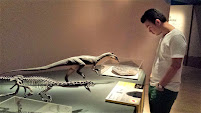Before setting foot on the Holy Land, events and incidents described in the Bible sometimes appeared to be like once-upon-a-time kind of stories that happened at some distant and far away places. In particular, names of places and locations hardly have any impact on the appreciation of the events. That has changed after I visited Israel and part of Jordan.
Throughout the trip, we saw pilgrims doing specific acts to fulfill their long-held wishes - baptism at the Jordan River, touching a piece of relic, praying at a church and the list goes on.
There are people who may find it hard to accept the notion that believers need to "touch" a piece of stone or "feel" a hole in a rock projection or be baptized in the very water Jesus was baptized in order to feel connected to God and be assured of His power.
***************************************************
Pilgrims come to be baptized in Jordan River.
**************************************************
We touched a limestone rock outcrop inside the Church of Primacy of St. Peter, Tabgha near Capernaum by the Sea of Galilee which according to tradition is the spot where Jesus is said to have laid out a breakfast of fish and bread for his disciples.
***************************************************
The Church of Gethsemane also known as the Church of All Nations at Mount Olives contains a stone protrusion which according to tradition is where Jesus knelt and prayed agonizingly the night before his trial and crucifixion. Many pilgrims come to touch and pray at this relic.
***************************************************
At the Stone of Unction also known as the Stone of Anointing inside the Church of the Holy Sepulchre, Jerusalem, we saw streams of people stopping to touch or pray at this relic. According to tradition, this is the place where the body of Jesus was laid after being taken down from the cross and prepared for burial.
Even Pope Francis stopped to pray at this relic during his recent visit to the Holy Land.
***************************************************
Long queue of pilgrims waiting to touch the rock of Calvary in the Chapel of Crucifixion inside the Church of the Holy Sepulcher. According to tradition, the rock of Calvary contains a cavity said to be where the cross that was used to crucify Jesus was planted.
*********************************************
Many find such acts objectionable because it is bordering idolatry and cause people to focus on objects rather than the divine being. But then, going through rituals and touching items deemed holy and powerful has been a Jewish tradition. Humans are just curious and they love to touch and see.
Zacchaeus climbed a sycamore tree in order to "see" Jesus. For his effort, salvation came to him (Luke 19:1-10).
In Jericho, we stopped by a sycamore tree to remember Zacchaeus.
A woman who simply believed that she would be cured of her internal bleeding problem of 12 years if only she could "touch" the cloak of Jesus. She did just that and she was healed (Mark 5: 25-34).
Naaman, an army commander who suffered from leprosy was told by Prophet Elisha that if he wanted to be cured, he had to go through the ritual of washing himself 7 times in Jordan River. Though reluctantly, he followed through and he was cured (2 Kings 5).
As long as there are individuals who believe in a powerful being in the unseen realm, there will not be a definitive answer whether one needs to touch some holy objects to affirm belief or simply just believe when told to believe.














































.jpg)
